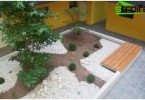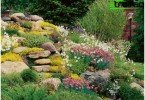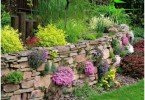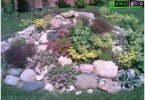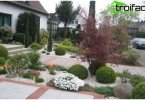Plants are not only a source of food, but also natural decorations. And the lack of space has long been no reason to save on beauty. The vertical placement of ampelous plants looks especially impressive, because they are characterized by such features suitable for this role as drooping branches, climbing stems, elongated inflorescences. With the help of hanging forms you can green the windowsill, porch or porch, they are perfect for a gazebo or hedge. Using ampelous plants, create partitions that visually divide the space of a room or garden.
Content
- What plants are used as ampelous
- Beautifully flowering ampelous plants
- Decorative foliage ampelous plants
What plants are used as ampelous
Use in vertical gardening implies some special requirements for the life form of plants. Unlike erect and rosette forms, most ampoules have elongated shoots that either wrap around a support or climb on it with a antennae, or hang under its own weight or spread along the ground. Ampel plants are divided into flowering and decorative deciduous, this diversity allows you to create compositions for every taste. Both those and others are annual or perennial. Particularly popular are the flowering annuals, and breeders are constantly struggling to create new varieties, with shoots that are resistant to the action of the wind, and flowers that will not cause visible damage to the summer rain or direct sunlight.
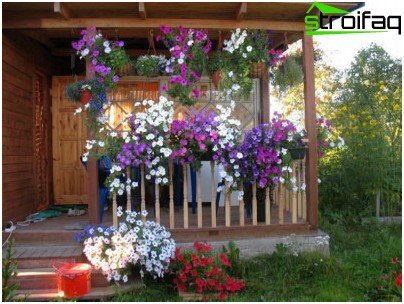
Ampel plants are an ideal decoration for almost any building and premises
Perennial ampelous plants differ from annuals only in that, with the onset of the cold season, one individual, the so-called mother liquor, is transferred to a warm room. In spring, it becomes the basis for vegetative propagation; therefore, among perennial species, varieties capable of rapidly increasing biomass are especially valued.
Beautifully flowering ampelous plants
- Petunia is an annual from the nightshade family. Since mid-spring, it is sold in literally every flower shop: it is a wonderful ampel plant for a garden, a balcony, a gazebo, as well as for urban landscaping. It differs in a wide variety of colors and flower shapes, and the length of the shoots varies from 20 cm to 2 m. Petunia is resistant to adverse weather conditions, can grow in partial shade and in bright light, responds well to pinching, tolerates drought, but is demanding on soil fertility. , which should include peat and humus.
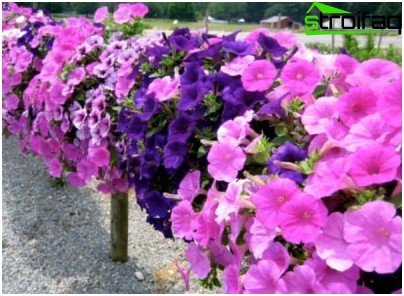
The unpretentiousness and variety of colors of petunias makes it one of the most popular ampelous plants
- Lobelia, which belongs to the bell family, but differs from ordinary bells in the asymmetric shape of a flower, is loved by gardeners for its beautiful bright blue or blue color. The shoots of ampel lobelia reach a length of 50 cm. The soil should not be too fertile, since in nature this plant lives on stones. Lobelia does not tolerate drying out, and it is better not to plant it in direct sunlight. But in partial shade, on the eastern, western and even northern balconies, she will feel great. Since the plant is demanding on humidity, in hot weather it should often be watered and sprayed. As a reward for these chores, the lobelia will delight the owner with a heavenly blue, which is good not only in itself, but also as a background for many other ornamental plants.
- Bacopa is a rapidly gaining popularity representative of the Noricaceae family, has a gamut of flower colors from bright blue to white or pink. It is unpretentious, prefers direct sunlight, responds well to pinching, is undemanding to soil, but likes frequent and plentiful watering.
- Fuchsia from the family of fireweed also forms ampelous forms. Fuchsia flowers can have a variety of colors, from pale pink to dark purple, with usually a combination of two contrasting shades within the flower. The plant should be exposed to open air only when the danger of frost, which fuchsia does not tolerate, passes. This sissy will feel bad in the drafts and in direct sunlight. Penumbra, east or west side, a place closed from the winds, moderately fertile soil, regular mineral top dressing, not too scarce, but not too plentiful watering – these are ideal conditions for keeping this plant.
- Alsobia, belonging to the exotic Gesneriaceae family, came to us from the forests of South America. She will delight with beautiful tubular white flowers with a fringed edge throughout the summer. Unpretentious, but thermophilic, does not like drafts, prefers eastern and western expositions, light soils, regular and moderate watering. Alsobia does not tolerate water entering the leaves, so a narrow-spout watering can should be used for it. It is also necessary to pay attention to drainage: stagnation of moisture for this plant is undesirable.
Decorative foliage ampelous plants
- Tradescantia from the family of Commelinas is indispensable in the winter garden of a beginner grower. It is very resistant to adversity, and in addition, it is represented by a huge number of species and varieties, the color of the leaves of which can vary from lilac to silver. Moderate sunlight, regular watering with soft water, mineral fertilizing every two weeks, as well as periodic spraying will allow the plant to feel comfortable. The care for the species that came from arid and desert regions, which are characterized by pubescent leaves, is somewhat different. It is not worth spraying such tradescans, you also need to allow the drying of an earthen coma from time to time.
- Dichondra is a representative of the bindweed family, recently, but at the same time confidently debuting in floriculture. The shoots of this plant, covered with spectacular green or silver leaves, can reach a length of 2 m. Moreover, reaching the soil, they are able to root and create a continuous carpet. For this feature, dichondra was especially fond of landscape designers, creating real waterfalls from it. In the photo, the ampule plant of dichondra looks like a brilliant stream. It can be planted in the shade and in the open sun, depending on the color of the leaves. Dichondra prefers plentiful watering and moist air, but is able to tolerate short-term drying of the soil. In order for the crown of the plant to be thick, it should be regularly cut and fed.
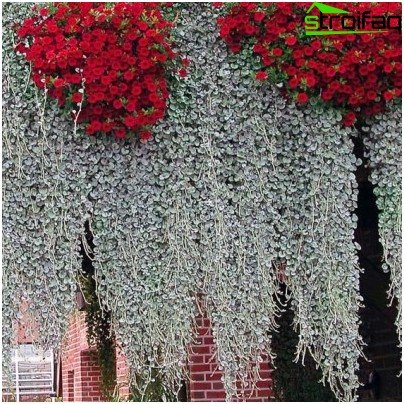
Silvery dichondria waterfalls are good in combination with flowering species
Rules for planting ampelous plants
Features of placement of suspended plants make the issue of their planting especially important. Indeed, who would like it if water flows from a pot located at eye level or above your head? Therefore, for ampelous plants use special containers.
- Hanging baskets. They look great in the garden and on the terrace, but you can also hang the basket in the room from the ceiling or mount it on the wall: such elements are indispensable for rooms in ethnic style. If you use fishing line as a suspension, you can achieve the effect of free floating of the plant in the air. Baskets can be made not only from rods, but also from wire or a plastic cord.
- Pots. The problem of excess moisture can be solved in this case in two ways. The first option is a plastic pot with a pallet attached to it. Such a tray can be filled with moss, foam or other spongy material capable of holding a large volume of water. In the second version, the pots are made of coarse clay, without a bottom hole and a tray, the evaporation of excess moisture occurs directly through the material of the walls.
- Wooden flower pots. An option close to baskets and also very appropriate for ethnic style. Evaporation can go directly through the wood, if irrigation is carried out at least 2-3 times a week.
Plastic dishes are the easiest way to solve the problem of planting ampelous plants, but at the same time it is also the least aesthetic. Over time, plastic pots can be decorated with descending stems and leaves, when they are bare they do not look very attractive. On the other hand, creative connoisseurs can make a container for an ampel plant from almost anything. The most ordinary pan will fit perfectly into the style if you decorate it with pieces of bark, shells or any other natural material. The only condition is to provide a way for the evaporation of water in the tank.
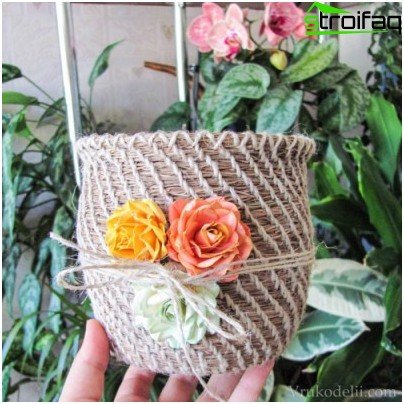
Home-made pots for ampelous plants will add a special cosiness
Growing Features
Features of care for ampelous plants are primarily associated with their watering. You cannot pour too much water, especially if the evaporation from the container with the plant occurs through the walls of the vessel. Stagnant water can cause plant disease, rotting of the roots, and the growth of pathogenic bacteria, so the excess should be drained. Ampel plants also need a thick drainage layer. For watering, it is convenient to use a watering can with a long narrow curved nose. If plants decorate an apartment or office, in winter they need to be sprayed often, because they suffer from dry air caused by heating. In addition to aerosol, you can use electric humidifiers. In ampelous plants, as in any others, shoots develop better from the illuminated side. Therefore, they should be rotated from time to time so that the crown does not become asymmetric. Since the volume of soil in which the root system is located is limited, regular organic and mineral fertilizing with a frequency of once every 1-2 weeks is necessary during the period of active growth. The possibilities of vertical gardening, which provide ampelous plants, allow you to fundamentally change your views on landscape design. This area of floriculture, of course, has a great future. Ease of care and the effectiveness of ampel plants every day increase the army of their fans.


